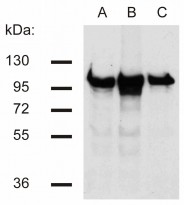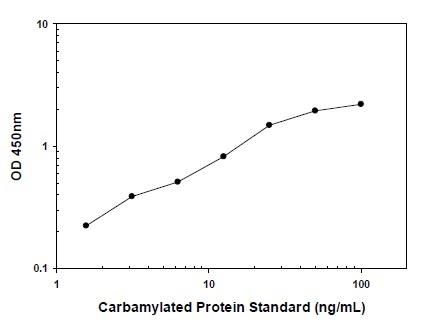anti-beta Catenin antibody [EM-22]
CAT.NO. : ARG62681
US$ Please choose
US$ Please choose
Size:
Trail, Bulk size or Custom requests Please contact us
*产品价格可能会有所调整,请以品牌方官网实时更新的价格为准,以确保准确性。
概述
| 产品描述 | Mouse Monoclonal antibody [EM-22] recognizes beta Catenin |
|---|---|
| 反应物种 | Hu, Ms, Hm |
| 应用 | FACS, ICC/IF, IP, WB |
| 特异性 | The clone EM-22 reacts with C-terminal part of beta-catenin, an 88 kDa multifunctional protein involved both in cell adhesion and in activation of transcription. |
| 宿主 | Mouse |
| 克隆 | Monoclonal |
| 克隆号 | EM-22 |
| 同位型 | IgG1 |
| 靶点名称 | beta Catenin |
| 抗原物种 | Human |
| 抗原 | Recombinant human beta-catenin |
| 偶联标记 | Un-conjugated |
| 別名 | CTNNB; armadillo; MRD19; Catenin beta-1; Beta-catenin |
应用说明
| 应用建议 |
| ||||||||||
|---|---|---|---|---|---|---|---|---|---|---|---|
| 应用说明 | * The dilutions indicate recommended starting dilutions and the optimal dilutions or concentrations should be determined by the scientist. | ||||||||||
| 阳性对照 | WB: HT29, FHC, DLD1, KW1, C57MG and 3T3. ICC/IF: HT29 |
属性
| 形式 | Liquid |
|---|---|
| 纯化 | Purified from cell culture supernatant by protein-A affinity chromatography. |
| 纯度 | > 95% (by SDS-PAGE) |
| 缓冲液 | PBS (pH 7.4) and 15 mM Sodium azide |
| 抗菌剂 | 15 mM Sodium azide |
| 浓度 | 1 mg/ml |
| 存放说明 | For continuous use, store undiluted antibody at 2-8°C for up to a week. For long-term storage, aliquot and store at -20°C or below. Storage in frost free freezers is not recommended. Avoid repeated freeze/thaw cycles. Suggest spin the vial prior to opening. The antibody solution should be gently mixed before use. |
| 注意事项 | For laboratory research only, not for drug, diagnostic or other use. |
生物信息
| 数据库连接 | |
|---|---|
| 基因名称 | CTNNB1 |
| 全名 | catenin (cadherin-associated protein), beta 1, 88kDa |
| 背景介绍 | Beta-catenin is a multifunctional protein involved both in cell adhesion and in activation of transcription. Calcium-dependent intercellular adhesion transmembrane glycoprotein E-cadherin interacts by its cytoplasmic domain with reciprocally bound alpha, beta and gamma catenin. Beta-catenin links this complex through alpha-actinin to the cytoskeleton. Functional cadherin-catenin system is important for invasiveness of tumour cells. Beta-catenin level in cytoplasm is controlled by glycogen synthase kinase-3 beta. When activity of this kinase is blocked (e.g. by excessive stimulation of Wnt signaling pathway), hypophosphorylated stable form of beta-catenin accumulates in the cytoplasm, translocates to the nucleus and activates transcription of genes including those that are involved in cell cycle control. As a result, cell division and neoplastic transformation are promoted. |
| 生物功能 | Key downstream component of the canonical Wnt signaling pathway. In the absence of Wnt, forms a complex with AXIN1, AXIN2, APC, CSNK1A1 and GSK3B that promotes phosphorylation on N-terminal Ser and Thr residues and ubiquitination of CTNNB1 via BTRC and its subsequent degradation by the proteasome. In the presence of Wnt ligand, CTNNB1 is not ubiquitinated and accumulates in the nucleus, where it acts as a coactivator for transcription factors of the TCF/LEF family, leading to activate Wnt responsive genes. Involved in the regulation of cell adhesion. Acts as a negative regulator of centrosome cohesion. Involved in the CDK2/PTPN6/CTNNB1/CEACAM1 pathway of insulin internalization. Blocks anoikis of malignant kidney and intestinal epithelial cells and promotes their anchorage-independent growth by down-regulating DAPK2. Disrupts PML function and PML-NB formation by inhibiting RANBP2-mediated sumoylation of PML (PubMed:17524503, PubMed:18077326, PubMed:18086858, PubMed:18957423, PubMed:21262353, PubMed:22647378, PubMed:22699938, PubMed:22155184). Promotes neurogenesis by maintaining sympathetic neuroblasts within the cell cycle (By similarity). [UniProt] |
| 产品亮点 | Related products: beta Catenin antibodies; beta Catenin Duos / Panels; Anti-Mouse IgG secondary antibodies; Related news: Besides tumor suppression, what’s p53 busy for during embryogenesis? Wnt / beta-catenin signaling for gastric fundus specification |
| 研究领域 | Cancer antibody; Cell Biology and Cellular Response antibody; Developmental Biology antibody; Neuroscience antibody; Signaling Transduction antibody |
| 预测分子量 | 85 kDa |
| 翻译后修饰 | Phosphorylation at Ser-552 by AMPK promotes stabilizion of the protein, enhancing TCF/LEF-mediated transcription (By similarity). Phosphorylation by GSK3B requires prior phosphorylation of Ser-45 by another kinase. Phosphorylation proceeds then from Thr-41 to Ser-37 and Ser-33. Phosphorylated by NEK2. EGF stimulates tyrosine phosphorylation. Phosphorylation on Tyr-654 decreases CDH1 binding and enhances TBP binding. Phosphorylated on Ser-33 and Ser-37 by HIPK2 and GSK3B, this phosphorylation triggers proteasomal degradation (PubMed:25169422). Phosphorylation on Ser-191 and Ser-246 by CDK5. Phosphorylation by CDK2 regulates insulin internalization. Phosphorylation by PTK6 at Tyr-64, Tyr-142, Tyr-331 and/or Tyr-333 with the predominant site at Tyr-64 is not essential for inhibition of transcriptional activity. Ubiquitinated by the SCF(BTRC) E3 ligase complex when phosphorylated by GSK3B, leading to its degradation. Ubiquitinated by a E3 ubiquitin ligase complex containing UBE2D1, SIAH1, CACYBP/SIP, SKP1, APC and TBL1X, leading to its subsequent proteasomal degradation (By similarity). S-nitrosylation at Cys-619 within adherens junctions promotes VEGF-induced, NO-dependent endothelial cell permeability by disrupting interaction with E-cadherin, thus mediating disassembly adherens junctions. O-glycosylation at Ser-23 decreases nuclear localization and transcriptional activity, and increases localization to the plasma membrane and interaction with E-cadherin CDH1. Deacetylated at Lys-49 by SIRT1. |
检测图片 (2)
ARG62681 anti-beta Catenin antibody [EM-22] WB image
Western blot: A. Murine 3T3 cell lysate, B. C57 cell lysate, C. KW1 cell lysate stained with ARG62681 anti-beta Catenin antibody [EM-22].
ARG62681 anti-beta Catenin antibody [EM-22] ICC/IF image
Immunofluorescence: HT-29 cells stained with ARG62681 anti-beta Catenin antibody [EM-22] (green)
Cell nuclei was stained with DAPI (blue).
 New Products
New Products




![anti-beta Catenin antibody [EM-22]](/upload/image/products/EM-22_1_210_205.jpg)
![anti-beta Catenin antibody [EM-22]](/upload/image/products/EM-22_2.jpg)
![anti-beta Catenin antibody [EM-22]](/upload/image/products/EM-22_1.jpg)













